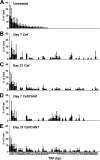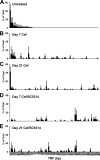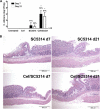Interplay between the gastric bacterial microbiota and Candida albicans during postantibiotic recolonization and gastritis
- PMID: 21986629
- PMCID: PMC3255670
- DOI: 10.1128/IAI.05162-11
Interplay between the gastric bacterial microbiota and Candida albicans during postantibiotic recolonization and gastritis
Abstract
The indigenous bacterial microbiome of the stomach, including lactobacilli, is vital in promoting colonization resistance against Candida albicans. However, there are gaps in our understanding about C. albicans gastric colonization versus disease, especially during the postantibiotic recovery phase. This study compared the gastric responses to C. albicans strains CHN1 and SC5314 in microbiome-disturbed and germfree mice to elucidate the contribution of the indigenous microbiota in C. albicans colonization versus disease and yeast-bacterium antagonism during the post-cefoperazone recolonization period. C. albicans can prevent the regrowth of Lactobacillus spp. in the stomach after cefoperazone and promote increased colonization by Enterococcus spp. Using a culture-independent analysis, the effects of oral cefoperazone on the gastric bacterial microbiota were observed to last at least 3 weeks after the cessation of the antibiotic. Disturbance of the gastric bacterial community by cefoperazone alone was not sufficient to cause gastritis, C. albicans colonization was also needed. Gastritis was not evident until after day 7 in cefoperazone-treated infected mice. In contrast, in germfree mice which lack a gastric microbiota, C. albicans induced gastric inflammation within 1 week of inoculation. Therefore, the gastric bacterial community in cefoperazone-treated mice during the first week of postantibiotic recolonization was sufficient to prevent the development of gastritis, despite being ineffective at conferring colonization resistance against C. albicans. Altogether, these data implicate a dichotomy between C. albicans colonization and gastric disease that is bacterial microbiome dependent.
Figures









Similar articles
-
Candida albicans and bacterial microbiota interactions in the cecum during recolonization following broad-spectrum antibiotic therapy.Infect Immun. 2012 Oct;80(10):3371-80. doi: 10.1128/IAI.00449-12. Epub 2012 Jul 9. Infect Immun. 2012. PMID: 22778094 Free PMC article.
-
Profiling inflammatory outcomes of Candida albicans colonization and food allergy induction in the murine glandular stomach.mBio. 2024 Nov 13;15(11):e0211324. doi: 10.1128/mbio.02113-24. Epub 2024 Sep 30. mBio. 2024. PMID: 39347572 Free PMC article.
-
Gene expression profiling reveals host defense strategies for restricting Candida albicans invasion and gastritis to the limiting ridge of the murine stomach.Infect Immun. 2024 Dec 10;92(12):e0043824. doi: 10.1128/iai.00438-24. Epub 2024 Nov 13. Infect Immun. 2024. PMID: 39535200 Free PMC article.
-
Enemies and brothers in arms: Candida albicans and gram-positive bacteria.Cell Microbiol. 2016 Dec;18(12):1709-1715. doi: 10.1111/cmi.12657. Epub 2016 Sep 14. Cell Microbiol. 2016. PMID: 27552083 Review.
-
Interplay between Candida albicans and Lactic Acid Bacteria in the Gastrointestinal Tract: Impact on Colonization Resistance, Microbial Carriage, Opportunistic Infection, and Host Immunity.Clin Microbiol Rev. 2021 Dec 15;34(4):e0032320. doi: 10.1128/CMR.00323-20. Epub 2021 Jul 14. Clin Microbiol Rev. 2021. PMID: 34259567 Free PMC article. Review.
Cited by
-
Characterization of Kazachstania slooffiae, a Proposed Commensal in the Porcine Gut.J Fungi (Basel). 2021 Feb 17;7(2):146. doi: 10.3390/jof7020146. J Fungi (Basel). 2021. PMID: 33671322 Free PMC article.
-
Proton pump inhibitors induced fungal dysbiosis in patients with gastroesophageal reflux disease.Front Cell Infect Microbiol. 2023 Aug 17;13:1205348. doi: 10.3389/fcimb.2023.1205348. eCollection 2023. Front Cell Infect Microbiol. 2023. PMID: 37662013 Free PMC article.
-
The interplay between gut bacteria and the yeast Candida albicans.Gut Microbes. 2021 Jan-Dec;13(1):1979877. doi: 10.1080/19490976.2021.1979877. Gut Microbes. 2021. PMID: 34586038 Free PMC article.
-
Systems biology of host-fungus interactions: turning complexity into simplicity.Curr Opin Microbiol. 2012 Aug;15(4):440-6. doi: 10.1016/j.mib.2012.05.001. Epub 2012 Jun 19. Curr Opin Microbiol. 2012. PMID: 22717554 Free PMC article. Review.
-
Transcriptomic insights into Candida albicans adaptation to an anaerobic environment.Microbiol Spectr. 2025 Jul;13(7):e0302424. doi: 10.1128/spectrum.03024-24. Epub 2025 May 22. Microbiol Spectr. 2025. PMID: 40401963 Free PMC article.
References
-
- Balish E, Jensen J, Warner T, Brekke J, Leonard B. 1993. Mucosal and disseminated candidiasis in gnotobiotic SCID mice. J. Med. Vet. Mycol. 31: 143–154 - PubMed
-
- Bistoni F, et al. 1993. Mucosal and systemic T helper cell function after intragastric colonization of adult mice with Candida albicans. J. Infect. Dis. 168: 1449–1457 - PubMed
Publication types
MeSH terms
Substances
Grants and funding
- R21-AI083473/AI/NIAID NIH HHS/United States
- KO8 DK0669907-01/DK/NIDDK NIH HHS/United States
- R01 DK070875/DK/NIDDK NIH HHS/United States
- R21-AI087869/AI/NIAID NIH HHS/United States
- P30 DK034933/DK/NIDDK NIH HHS/United States
- R21 AI087869/AI/NIAID NIH HHS/United States
- R21 AI083473/AI/NIAID NIH HHS/United States
- R01 DK087708/DK/NIDDK NIH HHS/United States
- P30-DK034933/DK/NIDDK NIH HHS/United States
- R01 AI064479/AI/NIAID NIH HHS/United States
- R01-AI064479/AI/NIAID NIH HHS/United States
- R01-DK087708/DK/NIDDK NIH HHS/United States
LinkOut - more resources
Full Text Sources
Medical
Miscellaneous

